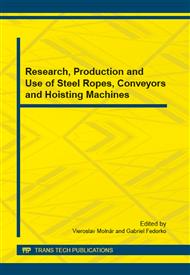p.3
p.9
p.15
p.22
p.28
p.33
p.39
p.45
A Wire Contact in the Construction of a Steel Rope
Abstract:
A rope is an important, highly effective and one of the oldest transportation systems used in transport by mankind. Nowadays, steel ropes are mainly used for moving loads in mining - coal and ore exploitation, vertical or horizontal transport of persons and goods by cranes, elevators, lifts and cable ways. In many cases steel wire ropes are employed in extreme conditions with respect to the load of the rope: high temperature plants, mining corrosive environments and etc. In terms of labor safety it is necessary to certify each rope people come in contact when working with loads or a rope is used for transportation. It has to be done earlier than a rope is put into operation or on the market. Despite the fact the tests were performed correctly, a rope may not achieve the desired rope life. The great impact on the life of a wire rope has its interaction with a device a rope is deployed on. Interaction of a steel wire rope with a device it is deployed on has a great impact on its life. Durability is also affected by the way a rope is loaded, its maintenance and regular re-examination as well as its construction. Design accuracy is assessed according to strength and deformation properties of wires a rope is made of and a rope cross-section construction is taken in account as well. The important aspect of steel wire rope durability (which can be mostly influenced by a manufacturer) is an appropriate design of diameters and angles of wires winding in accordance with exactly defined conditions of operation. The paper presents models of ropes equally loaded which eliminates the most unfavorable factors affecting their life cycle.
Info:
Periodical:
Pages:
3-8
Citation:
Online since:
October 2014
Authors:
Price:
Сopyright:
© 2014 Trans Tech Publications Ltd. All Rights Reserved
Share:
Citation:


